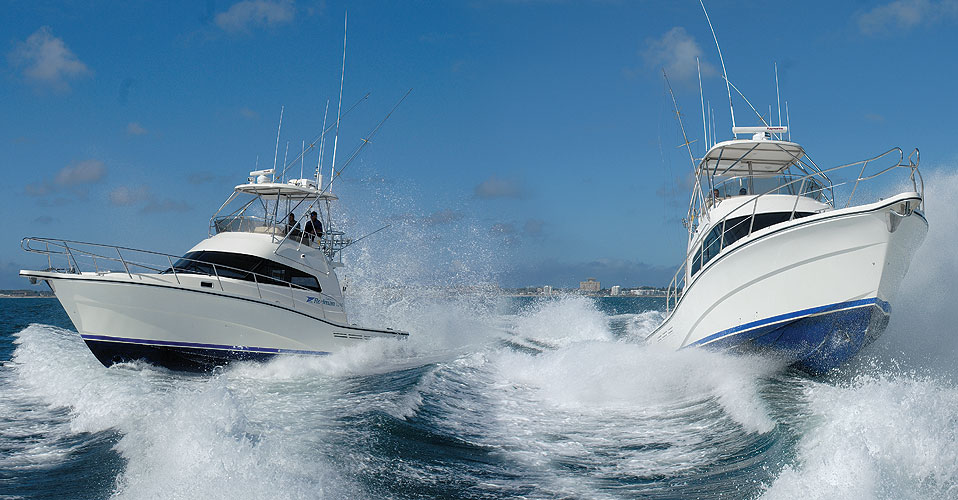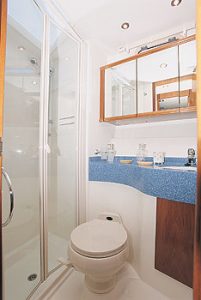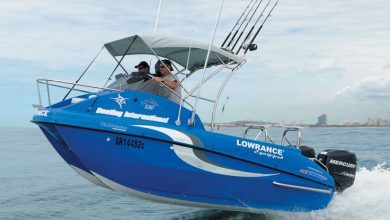Rodman Fisher-Pro
Tested by Erwin Bursik (May/June 2007)
MAGIC IN MOTION

TWO Rodman FisherPros exited Port Elizabeth harbour, turned to starboard and opened up their mighty engines as they thundered along the beachfront to rendezvous with a helicopter that was hovering off a pier halfway to Cape Recife.
To be aboard one of these incredible craft was a privilege. To later have the controls of Dawie van der Westhuisen’s Reel Magic in my hand was, to put it mildly, scintillating.
Back in 2003, as I walked around the Rodman factory in Spain where I was first introduced to the Rodman range of craft and first experienced their three walkaround sportfishing models, I also had my first view of the FisherPro.
This craft, a sportfisher within accepted norms, was then in her final stages of being fitted out. She stood proudly on her “dolly” at the top of the factory’s main slipway. I was spellbound. A craft of this size looks so much bigger out of the water and under the blazing lights of the enormous factory.
Rodman’s South African agent, Laurence Steytler, noticed my interest and informed me that the craft had been designed specifically for the American market, to meet that market’s desire for a dedicated sportfishing boat with specific features.
At that stage Laurence told me he was looking forward to the day when the first FisherPro would arrive in South Africa. Well, now there are two in the country.
Lying virtually opposite each other on the walk-on mooring in front of the Port Elizabeth Deep Sea Angling Club (PEDSAC), they were indeed an awesome sight to behold when I first arrived at the marina on the day I was to review these craft. I might add I had been waiting almost four years for this day to arrive.
Initially I ensconced myself on Derek Kibble’s Seasons which was not only the first Rodman FisherPro to be imported into South Africa, but also the boat on which Trevor Hansen caught his 935 lb blue marlin on 15th July 2006 out of Cape St Francis. (See the September/October 2006 issue of SKI-BOAT.) This catch was made even more impressive by the facts that it was fought using a 60kg class standup rig.
Standing on Seasons’ fishdeck during our cruise out to sea through PE harbour, my mind went back to the story and video of Trevor’s epic battle with a mighty marlin. I must admit to some feelings of anecdotal nostalgia, especially seeing as this is the biggest billfish landed on a South African-based sportfisher in our home waters. On the video one can easily see how well this fishdeck worked during the intense action of the fight, and also how well the craft manoeuvred during the critical time when the fish got close to the boat, an aspect I tried to emulate later during my time at the helm of Reel Magic.
Back to the present and reality, I was enjoying the ride and performance of Seasons as I watched Reel Magic thundering up behind us so that we could run parallel to one another along the coast. Standing on the fishdeck I could feel we were running quite quickly, but when the other FisherPro pulled up on our port side to match our speed, it felt as if we were only cruising. A quick look at the GPS confirmed, however, that both craft were running fast at a tad more than 20 knots.
“You got lucky,” said Dawie after my stern-to-stern transfer out at sea to board Reel Magic. “This is the first day in about two weeks that a craft has been able to put to sea because of bad weather.” On the day in question, a moderate south-westerly had started blowing. Off PE’s beachfront this tends to flatten the sea. Whilst the remnants of a swell were present, the small chop allowed the hulls of these two craft to work very efficiently.
Further out to sea, where there was no protection from land, the chop was a little bigger, but in no way could this sea challenge these big boats.
Having now extensively reviewed the range of Rodman craft imported into South Africa and come to really appreciate their capabilities even in rough water, I was keen to put the FisherPro — the only one on which I had not yet ridden — through her paces.

One aspect to note is that the below-water hull design of this craft is identical to the Rodman 1250 Walkaround which would lead one to think that the performance and feel of the craft would be very similar. However, the fact that the FisherPro is a good few tons heavier and has a more substantial superstructure was bound to make a difference. I was there to see how much this had changed her ride.
After the photo session was completed I had the privilege of skippering this craft for a few hours during which I could bond with this magnificent machine. Whilst becoming familiar with the new style of electronic controls as well as the instrumentation on Reel Magic, I set her on a south-easterly course at a relaxed speed of about 17 knots. The motors — twin 510hp Caterpillars — had settled on an easy tone and the hull planed easily over the water with the wind and sea on her starboard bow. Absolute bliss!
Following Dawie’s instructions, I now had the electronic (fly-by-wire) throttles synchronised electronically and was using only one lever to control these two big engines. With this control one only uses gentle, fingertip adjustments, not the pushing and shoving of the big levers of yesteryear. Another change from the past — due to the computerised governers — is that one cannot just push the throttle levers to “sunset” and expect the engines to suddenly absorb this injection of fuel and immediately reach full power. The governers control the degree at which power increases until full revs are achieved without undue stress to the engines. In other words, if the electronic controls were accidentally pushed to sunset, which would actually take very little effort, the revs would begin to increase, but in a smooth and controlled manner, giving the skipper plenty of time to correct the error of his ways.
It was through a number of speed trials that I really came to appreciate this hull’s performance. In many ways I could sense the similarity in ride to the Rodman 1250, but then her greatly increased weight tended to give her a much more sedate ride. The weight difference was even more marked because Reel Magic was carrying nearly 1 800 litres of diesel and 500 litres of freshwater in her oversized water tanks on the day of the test.
Throughout my review I found this craft extremely stable, especially laterally when trolling at the 7/8 knots needed to pull plastic lures. A craft like this will spend most of her time at sea doing exactly that, so it’s an important feature of such a craft’s performance. Many sportfishers I have been on tend to sway laterally in a reasonable side sea. In overall terms it’s not that serious, but it becomes a trifle uncomfortable after six or eight hours of trolling.
Ever since I took a Rodman 1250 out of the port of Vigo in north-west Spain, into the Bay of Biscay where I got the feel of this hull in serious sea conditions, I have admired her ability in our South African conditions. I therefore have no reason to feel that the FisherPro would be any different. If anything, with her extra weight she should ride even better in big water.
As I stated, Reel Magic is powered by twin Caterpillar 510hp turbo-charged engines, whereas Seasons has two Volvo 480hp turbo-charged units providing top speeds of 32 and 30 knots respectively.
By now regular readers of these reviews should know I have scant regard for high speed, so it will come as no surprise that I didn’t even begin to open them up to full taps. I was more than impressed with speeds in the 20-25 knot range. In fact, Reel Magic was true to her name, cruising magically at 2 000rpm and a speed of 18 knots.
Throughout the range of trolling speeds she performed effortlessly with revs between 800 and 1 200rpm to achieve SOW speeds between 4.5 and 8 knots. Her trolling wake is tight, not much wider than her transom, and stays that way a long way aft. This might be due to her props running in half tunnels, a system that provides stability and also gives her a shallower draft.
As I was unable to run her in big seas on the day of the test, refer to my review on the Rodman 1250 (January/February 2004 issue of SKI-BOAT) where this very similar hull was put through its paces.
I spent a good deal of time backing up and side-slipping her transom to manoeuvre her stern towards an imaginary marlin on the end of a line. Once I got used to the electronic controls, she responded perfectly to all the changes in transom positioning I desired.
The Rodman range of offshore craft became known for their 360° walkaround design, a feature that has a great number of advantages. The FisherPro obviously moves away from that concept, closer to the more traditional sportfisher design, but Rodman have still provided a wide, well protected gunnel passageway from the cockpit to the bow. This facility was especially useful when we returned to mooring, because due to a big surge in the harbour, attaching the mooring lines required a lot of running backwards and forwards along the walkway to get this tricky task accomplished.
What the FisherPro design has done is increase the width and overall size of the saloon area and helm station, providing more space and luxury in the gallery and cabin facilities.


In these areas I was pleased to note that the extremely high standard of finish — not only in looks, but also in quality and strength — is being maintained. I saw the quality of woodwork in the Rodman factory before installation and I am delighted that these standards are as high if not better in this, one of their latest models.
From the sportfisherman’s perspective, I will spend more time reviewing the fishing deck and flybridge facilities and design than the luxurious interior, for which the accompanying photographs speak a thousand words.

A good deal of research must have gone into perfecting the FisherPro which was originally designed for the very demanding United States sportfishing market, because the final product is both visually pleasing and very fishing-friendly, no matter how big your gamefishing quarry.
The fishdeck itself is very large with a substantial fighting chair taking centre stage. However, even with the chair’s footrest fully extended there is more than adequate space between it and the transom for the deck crew to work, whether they’re wiring a big fish or gaffing big tuna.
The height of the gunnel is great and will provide good support, softened by an inner, upholstered gunnel cushion, when an angler is working a fish on standup tackle or taking the leader on a big fish.
The outriggers have been fitted in such a way that they are practical to use when deployed. A centre rigger is also provided which is easily worked from the flybridge.
Access to and from the flybridge is quick, easy and safe. It is well designed with oval, teak steps and substantial rails on which to hold when one needs to get to the fishdeck in a hurry.
The flybridge is exceptionally large and comfortable for the size of craft. Both the skipper and his co-pilot have lots of room to skipper the craft and to swivel round to see what is happening on the fishdeck below them, as well as to view the spread of lures being trolled. I found it comfortable and safe standing and leaning against the aft flybridge rail, studying the sea behind Reel Magic, and I could get past the back of the skipper’s chair with ease.
In front of the flybridge helm station a clever arrangement of the casual seating allows visitors to the flybridge to relax and be in a comfortable position to chat to the skipper as well as have a 360° view of the surrounding ocean.
From the awe I felt at my first sight of the FisherPro in Rodman’s factory in Spain, to the joy I experienced actually skippering two of these superb craft at sea, I have become more and more impressed with the Rodman FisherPro. They’ll most certainly provide their very proud owners with many, many seasons of the utmost “reel magic”!





